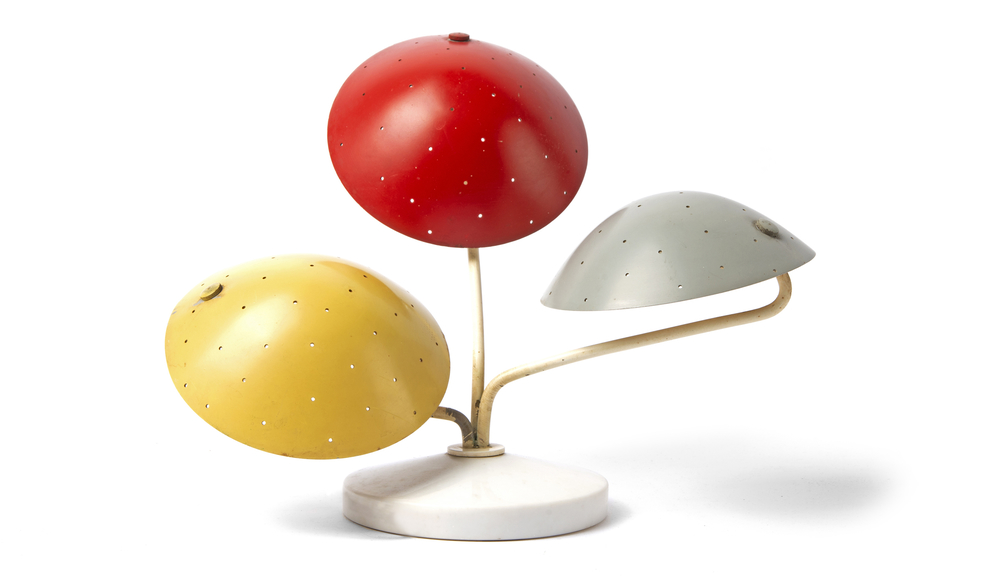Gino Sarfatti – master of minimalism
Gino Sarfatti – light maker, innovator and entrepreneur
If we speak about minimalism in design, you can trace that back to Sarfatti | Didier Krzentowski, Galerie Kreo

Gino Sarfatti
Lot 194, from Design For Living on 10th November 2020, a table lamp, 534B, was designed by Gino Sarfatti for Arteluce in 1951. The appearance of this rare light at auction has prompted The Pedestal to investigate this little-known Italian designer, albeit acknowledged by design insiders and aficionados as ‘one of the best’. Recently, broader interest in his designs was revived through the first retrospective exhibition of his work, The Design of Light, held in the centenary year of his birth, 2012, at the Triennale Design Museum, Milan.
From the 1930s until his retirement in 1973 – when he sold his firm, Arteluce, to lighting giant Flos in 1973 and dedicated his retirement in Lake Como to stamp collecting – Sarfatti created over 600 designs for floor lamps, pendant lights, table lamps, spot lights and chandeliers. Today, re-considered in the early 21st century, his creations look as fresh, bold and innovative as when they were first designed.
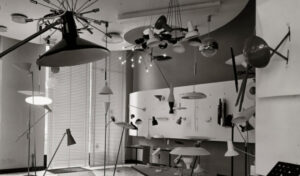
Gino Sarfatti’s first retail store, pictured in 1963 | Archivio Storico Flos
Uniquely, Sarfatti came to lighting design through his study of aeronautical engineering rather than the more conventional pursuit of art or architecture. He commenced his studies in Genoa but in 1935, at the age of 23, was forced to leave when his father’s business, based in Venice, was ruined through sanctions imposed by the United Nations. The family re-located to Milan where Sarfatti found employment as a salesman, and here by chance a family friend asked him to turn a vase into a light fitting – the technical challenge intrigued and absorbed him and so his new career path was set.
In 1939 Sarfatti set up Arteluce, arguably as wholly self taught he was able to immerse himself in the complete life cycle of the design process, from conception to production, he collaborated with artisans and architects to create stronger, lighter, and cheaper modernist lamps which had never before been seen in Italy. In 1943 on Italy’s surrender to Germany Sarfatti sought safety in Switzerland but returned to Milan two years later to re-start Arteluce once Liberation was declared. By 1951 during Milan’s post war economic boom the business had opened a retail outlet on busy Corso Vittorio and in 1961 a second was established on glamorous Via della Spiga, its interiors were designed by Sarfatti’s lighting collaborator Vittoriano Viganò.
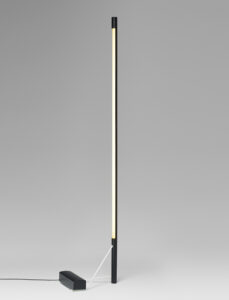
Model 1063, 1954, designed by Sarfatti; the design still retains its avant-garde credentials
What set Arteluce apart from other lighting designers and manufacturers? Sarfatti’s designs focused on the lightbulb and placed it, rather than the surrounding lamp, at the centre of the work. This ethos is perhaps best seen in the ultra-minimal model 1063, from 1954, it was to influence Italian floor lamp design for many years to come and was awarded the prestigious Grand Prix at the Milan Triennale. Model 1063 is regarded as the most eloquent example of Sarfatti’s purist vision of beauty in everyday objects. Coupled with these principles was Sarfatti’s relentless dedication to improving every single element of a light fitting, from the switch to the wiring and the reflectors. He also experimented with new materials, from the mid-1950s he worked with plexiglas and in the early 1970s he pioneered the use of halogen bulbs in fixtures.
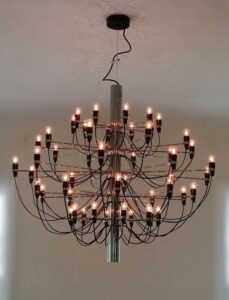
Model 2097/50, 1958, designed by Sarfatti; a mid-century modern version of the traditional lighting form
Into the 1960s, Arteluce became a creative hub for Italy’s most talented designers, with designs by many major talents, notably Franco Albini, Cini Boeri, Franca Helg, Ico Parisi, and Massimo Vignelli. One of Arteluce’s last projects – the lighting installation for the Teatro Regio opera house, Turin —comprising hundreds of pendant plexiglas tubes installed under the direction of legendary architect Carlo Mollino in 1972 is considered to be one of the company’s greatest achievements.
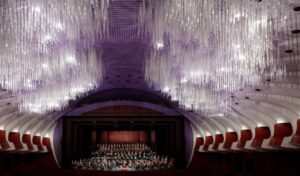
Arteluce’s last audacious project: a breath taking installation in plexiglas at Teatro Regio, Turin, designed by Sarfatti
Although on a much smaller scale, lot 194, model 534B, at auction this November, is equally imbued with Sarfatti’s design magic.
www.thepedestal.com | Lot 194: a rare table lamp, 534B, designed by Gino Sarfatti, 1951, for Arteluce
